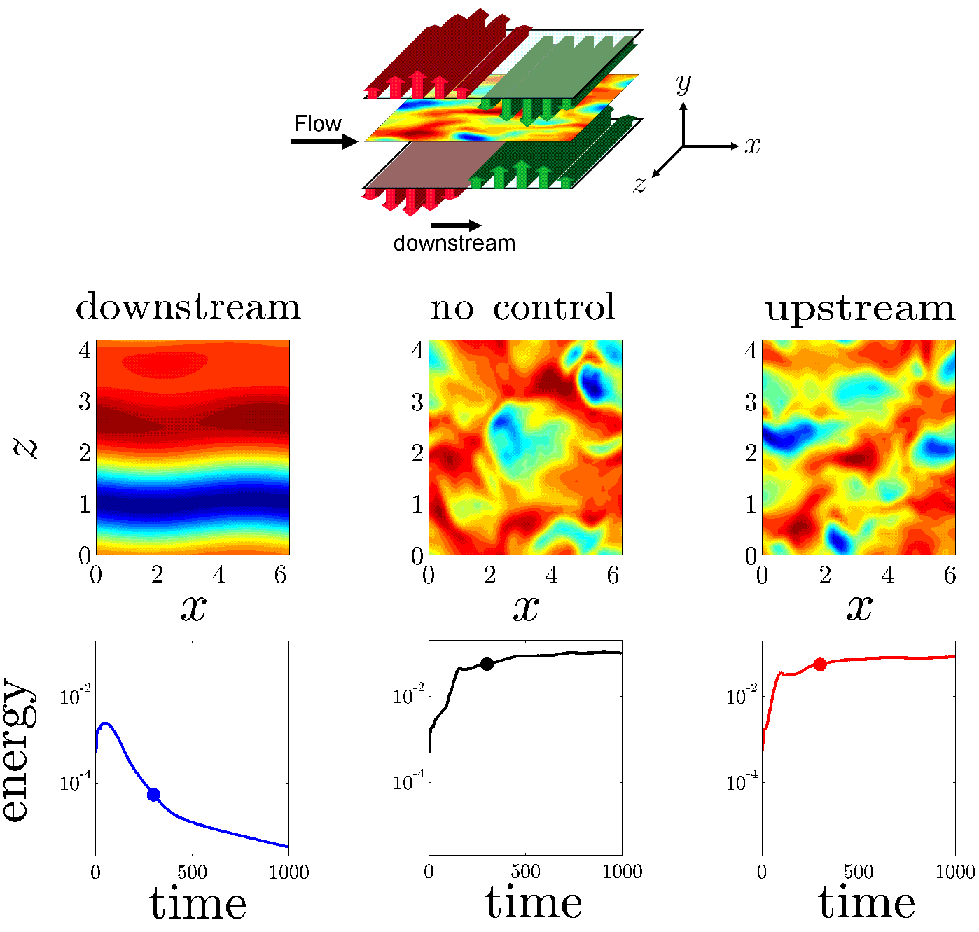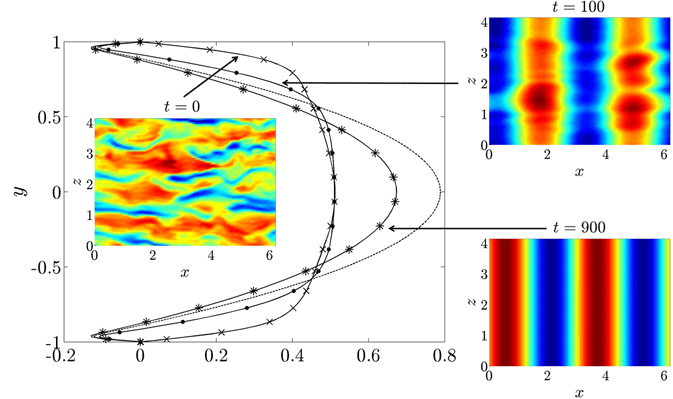Controlling the Onset of Turbulence
Spotlight
Our work on “Controlling the Onset of Turbulence by Downstream Traveling Waves” was selected as a Minnesota Supercomputing Institute (MSI) Research Spotlight for May 2011. An article about this work, aimed at a “general science” audience, was featured in the Spring 2011 issue of MSI Research Bulletin.
Project synopsis
In my recent research, I have developed theory and techniques for design and optimization of spatially and temporally periodic turbulence suppression strategies. This is significant because of the critical effect that turbulence has on the fuel consumption and pollutant emission of vehicles. I have introduced a model-based approach to vibrational flow control, where the dynamics are impacted by zero-mean oscillations. As verified by high-fidelity simulations of the nonlinear flow dynamics, my method of turbulence suppression surpasses what was earlier thought possible. I am also investigating flow control as a means for increasing aerodynamic efficiency (i.e., captured energy output) of wind turbines, thereby enabling cost effective wind electricity generation.
The methodology has been applied to study transition in a channel flow subject to surface actuation in the form of streamwise traveling waves. For small amplitude actuation, a weakly nonlinear analysis was utilized to determine base flow modifications and assess the resulting net power balance. Sensitivity analysis of the velocity fluctuations around this base flow was then employed to design the traveling waves. Our simulation-free approach reveals that, relative to the flow with no control, the downstream traveling waves with properly designed speed and frequency can significantly reduce high flow sensitivity, which makes them well-suited for controlling the onset of turbulence. In contrast, the velocity fluctuations around the upstream traveling waves exhibit larger sensitivity to disturbances and, consequently, promote turbulence. Our theoretical predictions, obtained by perturbation analysis (in the wave amplitude) of the linearized flow equations with spatially periodic coefficients, have been verified using high-fidelity simulations of the nonlinear flow dynamics; see figures below. These showed that a positive net efficiency as large as 25% relative to the uncontrolled turbulent flow can be achieved with downstream waves. Our work has demonstrated that the theory developed for the linearized flow equations with uncertainty has considerable ability to predict full-scale phenomena, and that transition can be inhibited by reducing the tremendous sensitivity in flow dynamics via active or passive means.
 |
Figure 1 (Controlling the onset of turbulence): Color plots: the velocity
fluctuations in the  -direction at the center-plane of the channel at
time
-direction at the center-plane of the channel at
time  for the uncontrolled flow with
for the uncontrolled flow with  and flows
subject to downstream and upstream traveling waves (generated by blowing and
suction along the walls). Last row: the fluctuations’ kinetic energy as a
function of time. The downstream traveling waves prevent the flow from becoming
turbulent by suppressing growth of fluctuations’ energy, while the uncontrolled
flow and the upstream traveling waves trigger transition to turbulence by
promoting growth of fluctuations’ energy. In flows that are not turbulent flow
patterns are very regular (downstream waves), and in turbulent flows they are
complex and disordered (uncontrolled and upstream waves).
and flows
subject to downstream and upstream traveling waves (generated by blowing and
suction along the walls). Last row: the fluctuations’ kinetic energy as a
function of time. The downstream traveling waves prevent the flow from becoming
turbulent by suppressing growth of fluctuations’ energy, while the uncontrolled
flow and the upstream traveling waves trigger transition to turbulence by
promoting growth of fluctuations’ energy. In flows that are not turbulent flow
patterns are very regular (downstream waves), and in turbulent flows they are
complex and disordered (uncontrolled and upstream waves).
 |
Figure 2 (Relaminarization): Mean velocity (lines) and streamwise velocity
(color plots) at  . Simulations are initiated by a fully developed
turbulent flow with
. Simulations are initiated by a fully developed
turbulent flow with  :
:  ,
,  ;
;  ,
,  ; *,
; *,
 . The dashed line identifies the laminar mean velocity induced by the
downstream traveling waves.
. The dashed line identifies the laminar mean velocity induced by the
downstream traveling waves.
Relevant Publications
Model-based design of transverse wall oscillations for turbulent drag reduction
R. Moarref and M. R. Jovanovic
J. Fluid Mech., vol. 707, pp. 205-240, 2012.Controlling the onset of turbulence by streamwise traveling waves. Part 1: Receptivity analysis
R. Moarref and M. R. Jovanovic
J. Fluid Mech., vol. 663, pp. 70-99, 2010.Controlling the onset of turbulence by streamwise traveling waves. Part 2: Direct numerical simulations
B. K. Lieu, R. Moarref, and M. R. Jovanovic
J. Fluid Mech., vol. 663, pp. 100-119, 2010.Turbulence suppression in channel flows by small amplitude transverse wall oscillations
M. R. Jovanovic
Phys. Fluids, vol. 20, no. 1, p. 014101 (11 pages), 2008.